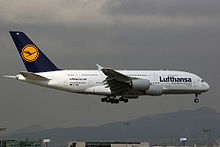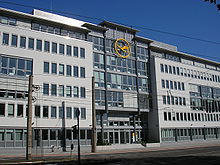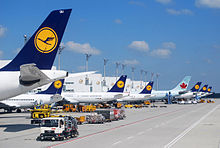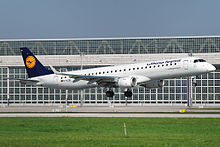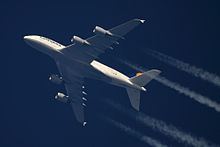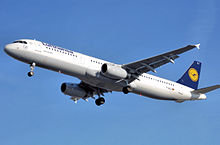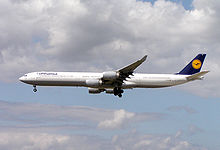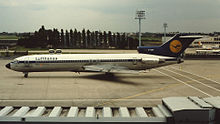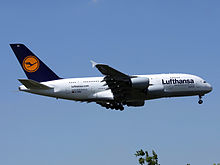- Lufthansa
-
"LHT" redirects here. For information about Left-hand traffic, see Left-hand traffic.This article is about the airline in operation today.. For other airlines of that name, see Lufthansa (disambiguation).
Lufthansa
Deutsche Lufthansa AG
IATA
LHICAO
DLHCallsign
LUFTHANSAFounded 1953 Commenced operations 1954 Hubs Focus cities - Berlin Tegel Airport (Closes June 2012)
- Hamburg Airport
- Stuttgart Airport
Frequent-flyer program Miles & More Airport lounge HON / Senator Lounge Alliance Star Alliance Fleet size 287 excl. subsidiaries
710 inc. subsidiaries excl. sharesDestinations 221 Company slogan There's no better way to fly Parent company Lufthansa Group Headquarters Cologne, Germany Key people - Jürgen Weber (Head of Supervisory Board)
- Christoph Franz (CEO)
- Stefan Lauer (Aviation Services and Human Resources)
- Stephan Gemkow (CFO)
Revenue €27.324 billion (2010)[2] Profit €1.1 billion (2010) Website www.lufthansa.com Deutsche Lufthansa AG (FWB: LHA, OTC Markets Group: DLAKY) (German pronunciation: [ˈdɔʏt͡ʃə ˈlʊfthanza]) is the flag carrier of Germany and the largest airline in Europe in terms of overall passengers carried. The name of the company is derived from Luft (the German word for "air"), and Hansa (after the Hanseatic League, a powerful medieval trading group).
The airline is the world's fourth-largest airline in terms of overall passengers carried, operating services to 18 domestic destinations and 203 international destinations in 78 countries across Africa, Americas, Asia and Europe. Together with its partners Lufthansa services around 410 destinations.[3] With over 710 aircraft[4] it has the second-largest passenger airline fleet in the world when combined with its subsidiaries.
Lufthansa's registered office and corporate headquarters is in Deutz, Cologne, with its main operations base (Lufthansa Aviation Center (LAC) and primary traffic hub at Frankfurt Airport in Frankfurt am Main with a second hub at Munich Airport.[3][5][6][7] The majority of Lufthansa's pilots, ground staff, and flight attendants are based in Frankfurt.[8]
Lufthansa is a founding member of Star Alliance, the world's largest airline alliance, formed in 1997. The Lufthansa Group employs 117,000 people worldwide of 146 nationalities. In 2010, over 90 million passengers flew with Lufthansa (not including Germanwings and Brussels Airlines).
Contents
History
1950s: Post-war reformation
Lufthansa traces its history back to 1926 when the Deutsche Luft Hansa was formed in Berlin, an airline that served as flag carrier of the country until 1945 when all services were suspended following the defeat of Germany in World War II. The new Lufthansa was formed on 6 January 1953 as Aktiengesellschaft für Luftverkehrsbedarf, a company for air traffic demand, and was renamed Deutsche Lufthansa Aktiengesellschaft and relaunched as an airline on 6 August 1954. While Lufthansa claims DLH's history as its own, it is important to note that it is not the legal successor of the company founded in 1926. On 1 April 1955 Lufthansa launched scheduled service within Germany using the Convair 340. International operations started on 15 May 1955, with flights to points in Europe, followed by services to New York City from 8 June of that year using Lockheed Super Constellations aircraft, and on South Atlantic routes from August 1956.
East Germany attempted to establish its own airline in 1955 using the Lufthansa name, but this resulted in a dispute with West Germany, where the airline was already in operation. East Germany created its national airline Interflug in 1958, and the East German Lufhansa ceased to exist and merged into Interflug in 1963.[9] Lufthansa (and all other West German airlines) was banned from flying into West Berlin until the demise of the GDR regime.
1960s: Jetliner introduction
In 1958, Lufthansa placed an order for four Boeing 707s, used to start jet services from Frankfurt to New York in March 1960. Boeing 720s were later bought to back up the 707 fleet. In February 1961, Far East routes were extended beyond Bangkok, Thailand to Hong Kong and Tokyo. The cities of Lagos, Nigeria and Johannesburg, South Africa were added in 1962.
Lufthansa introduced the Boeing 727 into service in 1964 and in May of that same year they began the Polar route from Frankfurt to Tokyo. In February 1965, the company placed an order for twenty-one Boeing 737 medium-haul jets, which were introduced into service in 1968.
Lufthansa was the first customer to purchase and also bought the largest number of Boeing 737 aircraft, and was one of only four buyers of the new 737-100s (the others were NASA, Malaysia-Singapore Airlines and Avianca– while the NASA airframe was technically the first constructed, it was the last delivered and originally intended for delivery to Lufthansa). In doing so, Lufthansa became the first foreign launch customer for a Boeing commercial plane.
1970s–1980s: The wide-body era
The beginning of the wide-body era for Lufthansa was marked with the inaugural Boeing 747 flight on 26 April 1970. In 1971 Lufthansa began service to South America. In 1979, Lufthansa and Swissair were launch customers for the advanced new Airbus A310, with an order for twenty-five aircraft.
The company's fleet modernisation programme for the 1990s began on 29 June 1985 with an order for fifteen Airbus A320s and seven Airbus A300-600s. Ten Boeing 737-300s were ordered a few days later. All of the aircraft were delivered between 1987 and 1992. Lufthansa also bought Airbus A321, Airbus A340 and the Boeing 747-400.
In 1987 Lufthansa together with Air France, Iberia and SAS founded Amadeus, an IT company (also known as a GDS) that would enable travel agencies to sell the founders and other airlines' products from a single system.
Lufthansa adopted a new corporate identity in 1988. The fleet was given a new livery while cabins, city offices and airport lounges were redesigned.[citation needed]
1990s–2000s: Further expansion
On 28 October 1990, 25 days after reunification, Berlin became a Lufthansa destination again. On 18 May 1997 Lufthansa, Air Canada, Scandinavian Airlines, Thai Airways and United Airlines formed the Star Alliance, the world's first multilateral airline alliance.
In 2000 Air One became a partner airline of Lufthansa and nearly all Air One flights were code-shared with Lufthansa until the purchase of Air One by Alitalia. Lufthansa has a good track record for posting profits, even in 2001, after 9/11, the airline suffered a significant loss in profits but still managed to stay 'in the black'. While many other airlines announced layoffs (typically 20% of their workforce), Lufthansa retained its current workforce.[10]
In June 2003, Lufthansa opened Terminal 2 at Munich's Franz Josef Strauß Airport to relieve its main hub, Frankfurt, which was suffering from capacity constraints. It is one of the first terminals in Europe partially owned by an airline.
On 17 May 2004, Lufthansa became the launch customer for the Connexion by Boeing in-flight online connectivity service.
On 22 March 2005, SWISS merged with Lufthansa Airlines. The merger included the provision that the majority shareholders (the Swiss government and large Swiss companies) be offered payment if Lufthansa's share price outperforms an airline index during the years following the merger. The two companies will continue to be run separately.
On 6 December 2006, Lufthansa placed an order for 20 Boeing 747-8I airliners, becoming the launch customer of the type. The airline is also the second European airline to operate the Airbus A380 (after Air France). Their first A380 was delivered on 19 May 2010.[11]
Corporate affairs and identity
Headquarters
Lufthansa's corporate headquarters is located in Cologne.[12]
In 1971 Lawrence Fellows of The New York Times described the then-new headquarters building that Lufthansa occupied in Cologne as "gleaming."[13] In 1986 terrorists bombed the headquarters of Lufthansa.[14] No people received injuries as a result of the bombing.[15]
In 2006 the builders laid the first stone to the new Lufthansa headquarters in Deutz, Cologne. By the end of 2007 Lufthansa planned to move 800 employees, including the company's finance department, to the new building.[16]
Several Lufthansa departments are not located in the headquarters; instead they are located in the Lufthansa Aviation Center at Frankfurt International Airport in Flughafen, Frankfurt. The departments include Corporate Communications,[17] Investor Relations,[18] and Media Relations.[19]
Subsidiaries
In addition to its main operation, Lufthansa has several subsidiaries, including:
Airline subsidiaries:- Air Dolomiti, an airline headquartered in Ronchi dei Legionari, Italy, wholly owned by Lufthansa.
- Austrian Airlines, the national airline of Austria, based in Schwechat, Austria, wholly owned by Lufthansa.
- British Midland International, a UK airline, wholly owned by Lufthansa.
- Brussels Airlines: On 1 July 2009, Lufthansa acquired a 45 percent stake in the Belgian airline with an option to acquire the remaining shares in 2011.
- Edelweiss Air, the charter arm of Swiss International.
- Eurowings a regional carrier, 49% owned by Lufthansa.[20][21]
- Germanwings, wholly owned by Lufthansa, Germanwings was previously the low-cost subsidiary of Eurowings.
- Jade Cargo International, was established in October 2004. Lufthansa Cargo owns 25% of the company, remainder is held by Shenzhen Airlines, which has a 51% stake, and DEG – Deutsche Investitions- und Entwicklungsgesellschaft mbH, a subsidiary of the German state-owned KfW bank – with 24%. It started operations in March 2005 with intra-Asian services. It is the first cargo airline in China with foreign ownership[citation needed].
- JetBlue Airways, an airline headquartered in New York, 19% owned by Lufthansa.[22]
- Lufthansa Cargo, an air cargo company, wholly owned by Lufthansa.
- Lufthansa CityLine, a regional carrier, wholly owned by Lufthansa.
- Lufthansa Italia, a subsidiary which operates flights from Milan Malpensa to destinations across Europe, with a fleet of eight Airbus A319 aircraft. It was intended to capture a large slice of the Milan market following major cutbacks by Alitalia as a result of its hub change to Rome Fiumicino Airport.[23] However the Lufthansa Italia brand will be closed down on 29 October 2011 and the eight Airbus A319 aircraft will be returned to the parent company.[24]
- Luxair – Lufthansa holds a 13% stake.
- SunExpress, airline based in Antalya, Turkey; 50% owned by Lufthansa (The remainder is owned by Turkish Airlines).
- Swiss International Air Lines, an airline based at Basel Airport, wholly owned by Lufthansa.
- Ukraine International Airlines, a Ukrainian airline, 58.61 % owned by UIA Beteiligungsgesellschaft mbH, a 100 % subsidiary of Austrian Airlines.[25]
Other operations:
- Delvag, an insurance company specialising in air transport
- Global Load Control, a world leader in remote weight and balance services
- LSG Sky Chefs, the world's largest airline caterer, which accounts for one third of the world's airline meals
- Lufthansa Commercial Holding, in which Lufthansa holds a 19% stake. LCH contains over 400 service and finance companies of which Lufthansa holds shares
- Lufthansa Consulting, an international aviation consultant for airlines, airports and related industries
- Lufthansa Flight Training, a provider of flight crew training services to various airlines and the main training arm for the Airline's own pilots
- Lufthansa Regional, a brand operated by an alliance of several small regional airlines, including Lufthansa CityLine
- Lufthansa Systems, the largest European aviation IT provider
- Lufthansa Technik, aircraft maintenance providers
Brand history
The Lufthansa logo, an encircled stylized crane in flight, was created in 1918 by Otto Firle. It was part of the livery of the first German airline, Deutsche Luft-Reederei (abbreviated DLR), which began air service on 5 February 1919. In 1926 Deutsche Luft Hansa adopted this symbol, and in 1954 Lufthansa expressed continuity by adopting it, too.
The original creator of the name Lufthansa is believed to be F.A. Fischer von Puturzyn. In 1925 he published a book entitled "Luft-Hansa" which examined the options open to aviation policymakers at the time. Luft Hansa was the name given to the new airline which resulted from the merger of Junkers Luftverkehr AG and Deutscher Aero Lloyd.[26]
Alliances and partnerships
Commercial
Lufthansa is owned by private investors (88.52%), MGL Gesellschaft für Luftverkehrswerte (10.05%), Deutsche Postbank (1.03%) and Deutsche Bank (0.4%) and has 37,042 employees (at March 2007).[3]
On 14 December Lufthansa and US-based low-cost airline Jetblue announced the beginning of a partnership initiated through the 19% stake purchase in Jetblue shares by Lufthansa. This is the first major ownership investment by a European carrier in an American carrier since the EU–U.S. Open Skies Agreement became effective in 2008.
In late 2007, the Lufthansa cargo hub dispute was started by Russia. Lufthansa was forced to relocate its cargo hub from Kazakhstan to Russia.
On 28 August 2008, Lufthansa and Brussels Airlines announced that they were negotiating joining together.[27]
On 15 September 2008, it was jointly announced by both airlines that Lufthansa will acquire a 45% stake in Brussels Airlines with an option to acquire the remaining 55% from 2011. As a part of this deal Brussels Airlines will join Star Alliance. Brussels entered into the Star Alliance in December 2009.[28][29][30]
On 28 October 2008, Lufthansa exercised its option to purchase a further 60% share in BMI (additionally to the 20% Lufthansa already owned), this resulted in a dispute with former owner Sir Michael Bishop, though. Both parties reached an agreement at the end of June 2009, so the acquisition could take place with effect from 1 July 2009.[31] By acquiring the remaining 20% from Scandinavian Airlines Lufthansa has full control over BMI since 1 November 2009.[32]
In November, Lufthansa and Austrian announced a deal in which Lufthansa will buy the majority stock from the Austrian government. The deal was completed in January 2009. At the same time, Lufthansa announced that they are in serious talks with Scandinavian Airlines System about a merger between the two airlines but Lufthansa would have to make great changes to SAS before this is viable because of the financial state of Scandinavian Airlines System over the last few years. In May 2009, it announced that talks are occurring between about a "closer commercial co-operation" between the two companies, but that a takeover is not in Lufthansa's plans.[33] Additionally, it announced that if British Airways was unable to complete its merger with Iberia, it would attempt to begin talks with the Spanish airline itself.[34]
In 2010, Lufthansa was named in a European Commission investigation into price-fixing, but was not fined due to acting as a whistleblower.[35]
Technology
Until April 2009 Lufthansa inventory and departure control systems, based on Unisys were managed by LH Systems. Lufthansa reservations systems were outsourced to Amadeus in the early 1990s. Following a decision to outsource all components of the Passenger Service System, the functions were outsourced to the Altéa platform managed by Amadeus.
Partner airlines
Lufthansa built up a worldwide partner network, offering coordinated connections, common frequent flyer programs and code sharing. After the liquidation of Team Lufthansa, some of the former Team Lufthansa members were integrated into the partner program. All airlines remain independent and keep their own corporate identity. Lufthansa Partners around the world are:
- Air Malta, Malta
- Cirrus Airlines, Germany
- Air Dolomiti, Italy
- Luxair, Luxembourg
- Qatar Airways, Qatar
- Air China, China
- Jat Airways, Serbia
- Air India, India
- Aegean Airlines, Greece
- Ethiopian Airlines, Ethiopia
Destinations
Besides fellow Star Alliance members, Lufthansa has codeshare agreements with the following airlines (as of October 2011):[36]
- Air India
- Air Malta
- Avianca[37] (Future Star Alliance member)
- Cirrus Airlines
- Ethiopian Airlines (Future Star Alliance member)
- Jat Airways
- JetBlue Airways[38]
- Luxair
- Qatar Airways [ends 31 December]
- TACA Airlines (Future Star Alliance member)
Fleet
As of July 2011, the Lufthansa fleet consists of the following aircraft with an average age of 13.3 years:
Lufthansa Fleet[39][40][41][42][43] Aircraft In Service Orders Passengers F C Y Total Airbus A319-100 25 3 — 24 102 126 Airbus A320-200 46 23 — 32 114 146 Airbus A320neo — 25 TBA Airbus A321-100 20 — — 31 155 186 Airbus A321-200 31 9 — 31 155 186 Airbus A321neo — 5 TBA Airbus A330-300 15 3 8 48 165 221 Airbus A340-300 26 — 8 48 165 221 8 36 197 241 — 44 222 266 Airbus A340-600 24 — 8 60 238 306 — 66 279 345 Airbus A380-800 8 7 8 98 420 526 Boeing 737–300 33 — — 18 106 124 Boeing 737–500 23 — — 18 90 108 Boeing 747-400 30 — 8 80 234 330 8 66 279 345 8 52 310 378 Boeing 747-8I — 20 8 80 298 386 Total 287 95 Fleet history
Over the years, Lufthansa operated the following aircraft types:[44][45]
Lufthansa Mainline past fleet since 1955 Aircraft Introduced Retired Notes Airbus A300 1976 1984 1987 2009 Airbus A310 1984 2005 Airbus A319 1996 — Airbus A320 1989 — Airbus A321 1994 — Airbus A330-200 2002 2006 Airbus A330-300 2004 — Airbus A340-200 1993 2006 Airbus A340-300 1993 — Airbus A340-600 2003 — Airbus A380 2010 — Boeing 707 1960 1984 also used in cargo configuration Boeing 720 1961 1965 Boeing 727 1964 1993 Boeing 737-100 1968 1982 launch customer, dubbed City Jet Boeing 737–200 1982 1997 Boeing 737–300 1986 — Boeing 737–400 1992 1998 Boeing 737–500 1990 — Boeing 747–100 1970 1979 also used in cargo configuration Boeing 747–200 1971 2004 also used in cargo configuration Boeing 747-400 1989 — Convair CV-340/440 1955 1968 also used in cargo configuration Lockheed Super Constellation/Starliner 1955 1967 Douglas DC-3 1955 1960 Douglas DC-4 1957 Unknown cargo aircraft Douglas DC-8 1968 1996 cargo aircraft McDonnell Douglas DC-10 1974 1994 McDonnell Douglas MD-11 1998 — cargo aircraft Vickers Viscount 1958 1971 also used in cargo configuration Airbus A380
 Lufthansa Airbus A380 being towed to the hangar after testing, ready for its first scheduled flight on 6 June 2010 to Johannesburg[citation needed]
Lufthansa Airbus A380 being towed to the hangar after testing, ready for its first scheduled flight on 6 June 2010 to Johannesburg[citation needed]
On 6 December 2001 Lufthansa announced an order for 15 Airbus A380 superjumbos with 10 more options, which was confirmed on 20 December. The A380 fleet will be used for long haul flights from Frankfurt exclusively. The first aircraft that arrived on 19 May 2010 has been named "Frankfurt am Main". The first route of the Airbus A380 with Lufthansa was Frankfurt to Tokyo, with the first flight having taken place on 11 June 2010.[46] The second A380, named "München" (Munich) was delivered in July 2010, and the third, named "Peking" was delivered in August 2010; Lufthansa expects four deliveries in 2010.[47] Additionally to Tokyo, Lufthansa operates the A380 on routes to Beijing and Johannesburg (since 1 and 12 September 2010, respectively).[48] The airline also operates the A380 to New York, it uses JFK instead of Newark, the reason being Newark Airport is unable to handle the A380 at this time.[49] The airline also commenced seasonal A380 service to San Francisco International Airport on 10 May 2011, and to Miami International Airport on 10 June.
A380 Routes (All depart from Frankfurt):
- Tokyo
- Beijing
- Johannesburg
- Miami
- New York
- San Francisco [summer seasonal]
- Singapore
Aircraft Naming Conventions
In September 1960 the Lufthansa Boeing 707 (D-ABOC), which would serve the Frankfurt-New York intercontinental route, was christened Berlin after the divided city of Berlin by then-mayor Willy Brandt. Following the Berlin, other Lufthansa 707 planes were named "Hamburg", "Frankfurt," "München" and "Bonn." With these names, the company established a tradition of naming the planes in its fleet for German cities and towns or federal states, with a general rule of thumb that the airplane make, size, or route would correspond roughly to the relative size or importance of the city or town it was named after.
This tradition has continued to this day, with two notable exceptions until 2010. The Airbus A340-300 (D-AIFC Gander/Halifax) was named after Gander and Halifax, two Canadian cities along the standard flight path from Europe to North America. It became the first Lufthansa airplane named after a non-German city. The name is meant to commemorate the hospitality of the communities of Gander and Halifax, which served as improvised safe havens for the passengers and crew of the multitude of international aircraft unable to return to their originating airports after the closing of the North American airspace in the days following the terror attacks of 11 September 2001.
The other aircraft not named after a German city was the Airbus 321-100 (D-AIRA), which was designated Finkenwerder in honor of the collaborative Airbus facility in the borough of Hamburg-Finkenwerder, where parts of the Airbus models are manufactured.
In February 2010 the Lufthansa company announced that the first two Airbus A380 in its fleet would be named Frankfurt am Main and München, following its naming tradition. However, the two subsequent A380 planes are named after Lufthansa A380 destination cities. The third A380 delivered to Lufthansa (D-AIMC) is named Peking, the German version of Beijing, inscribed on the plane in both German and Mandarin characters. The fourth A380 (D-AIMD) is named Tokio, the German spelling of Tokyo. The fifth A380 (D-AIME) is named Johannesburg, the sixth (D-AIMF) is named Zürich, the seventh (D-AIMG) is named "Wien", German version of Vienna, the eighth (D-AIMH) is named "New York" while the ninth (D-AIMI) is named "Berlin".[50]
Vintage aircraft restoration
Lufthansa Technik, the airline's maintenance arm, restored a Junkers Ju 52/3m built in 1936 to airworthiness; this aircraft was in use on the 10-hour Berlin to Rome route, across the Alps, in the 1930s. Lufthansa is now restoring a Lockheed Super Constellation, using parts from three such aircraft bought at auction. Lufthansa's Super Constellations and L1649 "Starliners" served routes such as Hamburg-Madrid-Dakar-Caracas-Santiago. Lufthansa Technik recruits retired employees and volunteers for skilled labor.[51][52] Lufthansa sells aviation enthusiasts rides on the restored aircraft.
Cabin
Intercontinental
First Class: Lufthansa First Class is offered on most long-haul aircraft (Airbus A330-300, A340-300, A340-600 and A380-800, Boeing 747–400). Each seat converts to a two meter bed, includes laptop power outlets, as well as entertainment facilities. Meals are available on demand. Lufthansa offers dedicated First Class check in counters at most airports, and offers dedicated First Class lounges in Frankfurt and Munich, as well as a dedicated First Class Terminal in Frankfurt. Arriving passengers have the option of using Lufthansa's First Class arrival facilities, as well as the new Welcome Lounge. Lufthansa has introduced a new First Class product aboard the Airbus A380 and plans to gradually introduce it on all of its long-haul aircraft.[53]
Business Class: Lufthansa's long-haul Business Class is offered on all long-haul aircraft. Each seat converts to a two meter angled lie-flat bed, includes laptop power outlets and entertainment facilities. Lufthansa offers dedicated Business Class check in counters at all airports, as well as dedicated Business Class lounges at most airports, or contract lounges at other airports, as well as the Lufthansa Welcome Lounge upon arrival in Frankfurt.
Economy Class: Lufthansa's long-haul Economy Class is offered on all long-haul aircraft. All have a 31" seat pitch except the Airbus A340s, which have a 32" seat pitch. Passengers receive meals, as well as free drinks. In 2007, Lufthansa began installing personal Audio-Video-On-Demand (AVOD) screens in Economy Class. The Airbus A340s and A330s have been completely refitted with AVOD, while the 747s are in the process of being refitted . The Airbus A380s are being delivered with AVOD systems already installed.
European domestic
Business Class: Lufthansa's short-haul Business Class offers a 31"-32" seatpitch and is available on all A319, A320, A321 and Boeing 737 aircraft. Passengers receive meals and drinks, as well as access to dedicated Business Class check-in counters, and Lufthansa Business Class lounges. These aircraft are used on selected medium-haul flights. Inflight entertainment is not offered on any short-haul flights.
Economy Class: Lufthansa's short-haul Economy Class offers a 31" pitch and is available on all A319, A320, A321 and Boeing 737 aircraft. Passengers receive free beverages, and snacks or meals. Inflight entertainment is not offered on any short-haul flights.
In July 2010, Lufthansa announced a move to a new cabin with lighter seating in its European fleet, bringing capacity improvements equivalent to buying twelve new A320s.[54]
In December 2010, Lufthansa announced a new slimline seat developed by Recaro, which would allow higher seat densities and/or more legroom for passengers; Lufthansa has ordered 32000 of these seats, to be installed in 2011.[55]
Lounges
Lounge Access – Class Access – Status Notes Number on Network First Class Terminal First Class HON Circle FRA only 1 First Class Lounge First Class HON Circle FRA and MUC only 3 Senator Lounge First Class Senator (or higher)
Star Alliance Gold30 Business Lounge Business Class (or higher) Frequent Traveller (or higher) 26 Welcome Lounge Business Class (or higher) Frequent Traveller (or higher) FRA only
Intercontinental passengers only
No Star Alliance Gold1 Lufthansa operates four types of lounges: First Class, Senator, Business, and Welcome Lounges. Each departure lounge is accessible both through travel class, or Miles and More / Star Alliance status; the Welcome Lounge is limited to arriving premium Lufthansa passengers only.
First Class Terminal
Lufthansa operates a First Class Terminal at Frankfurt Airport. The first terminal of its kind; access is limited only to departing Lufthansa First Class, and HON Circle members. Approximately 200 staff care for approximately 300 passengers per day in the terminal, which features a full-service restaurant, full bar, cigar lounge, relaxation rooms and offices, as well as bath facilities. Guests are driven directly to their departing flight by Mercedes-Benz S-Class, Porsche Cayenne, Porsche Panamera or Mercedes-Benz Viano.
Miles & More
Lufthansa's frequent-flyer program is called Miles & More, and is shared among several European airlines, including Austrian Airlines, Adria Airways, Croatia Airlines, LOT Polish Airlines, Luxair, Swiss International Air Lines, and Brussels Airlines. Miles & More members may earn miles on Lufthansa flights and Star Alliance partner flights, as well as through Lufthansa credit cards, and purchases made through the Lufthansa shops. Status within Miles & More is determined by miles flown during one calendar year with specific partners. Membership levels include: Basic (no minimal threshold), Frequent Traveller (Silver, 35,000 mile threshold), Senator (Gold, 100,000 mile threshold, 130,000 for German residents), and HON Circle (Black, 600,000 mile threshold over two calendar years). All non-basic Miles & More status levels offer lounge access and executive bonus miles, with the higher levels offering more exclusive benefits.
Accidents and incidents
This is a list of accidents and incidents involving Lufthansa mainline aircraft since 1954. For earlier occurrences, refer to Deutsche Luft Hansa. For accidents and incidents on Lufthansa-branded flights which were operated by other airlines, see the respective articles (Lufthansa CityLine, Lufthansa Cargo, Contact Air and Air Dolomiti).
Fatal
- On 11 January 1959, a Lufthansa Lockheed Super Constellation (registered D-ALAK) crashed onto a beach shortly off Galeão Airport in Rio de Janeiro following a scheduled passenger flight from Hamburg. Of the 29 passengers and 10 crew members onboard, only three flight attendants survived. Investigation into the accident resulting in blaming the pilots for having executed a too low approach, which may have been caused by fatigue.[56]
- On 4 December 1961, a Lufthansa Boeing 720 (registered D-ABOK) crashed of unknown causes near Mainz during a training flight from Frankfurt to Cologne, killing the three occupants. It was the first crash involving an aircraft of that type.[57]
- On 15 July 1964, another Boeing 720 (registered D-ABOP) crashed during a training flight, with the three people on board losing their lives (in what was only the second crash for this aircraft type). The accident occurred near Ansbach after the pilots had lost control of the aircraft when executing an aileron roll.
- On 28 January 1966 at 17:50 local time, Lufthansa Flight 5 from Frankfurt to Bremen, which was operated using a Convair CV-440 Metropolitan registered D-ACAT, crashed 0.5 kilometres short of Bremen Airport, killing all 42 passengers and four crew members on board. The pilots had tried to execute a go-around when approaching the airport, during which the aircraft stalled and went out of control, possibly due to pilot error.[58]
- On 20 November 1974 at 07:54 local time, Lufthansa Flight 540, a Boeing 747–100 (registered D-ABYB), crashed shortly after take-off at Jomo Kenyatta International Airport. In what was the first air accident involving a Boeing 747, 55 of the 140 passengers and ten out of the seventeen crew lost their lives, making it the worst accident in the history of the airline.[59]
- On 26 July 1979 at 21:32 UTC, a cargo-configured Boeing 707 (registered D-ABUY) that was enroute Lufthansa Flight 527 from Rio de Janeiro to Dakar and onwards to Germany (at that time cargo flights were operated in-house, the Lufthansa Cargo subsidiary had not been founded yet) crashed shortly after take-off in a mountain 25 kilometres off Galeão Airport, killing the three crew members on board. A flawed communication between the pilots and the air traffic controller had resulted in the aircraft flying on a wrong path.[60]
- On 14 September 1993, Lufthansa Flight 2904, an Airbus A320-200 (registered D-AIPN) flying from Frankfurt to Warsaw with 64 passengers and four crew members on board, overran the runway upon landing at Warsaw-Okecie Airport and crashed into an earth embankment, resulting in the death of the co-pilot and one passenger.[61][62]
Non-fatal
- On 20 December 1973 at 00:33 local time, a Lufthansa Boeing 707 (registered D-ABOT) with 98 passengers and 11 crew members on board collided with a middle marker shack upon approaching Palam Airport in Delhi following a scheduled passenger flight from Bangkok (as part of a multi-leg flight back to Germany). There were no injuries, but the aircraft was damaged beyond repair. At the time of the incident, there had been poor visibility conditions.[63]
- On 18 October 1983, a Lufthansa cargo-configured Boeing 747-200 (registered D-ABYU) was severely damaged when it overshot the runway at Kai Tak Airport in Hong Kong, following an aborted take-off due to an engine failure. The three crew members on board survived without any notable injuries.[64]
- On 20 March 2001 at 12:00 local time, a Lufthansa Airbus A320-200 (registered D-AIPW) with 115 passengers and 6 crew members on board performed a severe banking manouvre upon take-off at Frankfurt Airport for a flight to Paris, this occurred because of a malfunction of the captain's sidestick. Maintenance workers had made a mistake with the electrical wiring, reversing the sidestick functions. A safe emergency landing was made using the Co-pilot's functional sidestick.[65]
- On 1 March 2008, Lufthansa Flight 44, an Airbus A320-200 registered D-AIQP flying from Munich to Hamburg experienced a wingstrike during a high crosswind landing at Hamburg Airport. The left wingtip struck the ground during the attempt, and the crew successfully executed a go-around. At the time, winds at the airport were gusting up to 49 knots due to Windstorm Emma. There were no injuries to the occupants.[66]
Hijackings
- In 1972, the year of the Munich Summer Olympics, there were four reported hijackings involving Lufthansa aircraft:
- On 22 February, a Boeing 747-200 (registered D-ABYD) with 172 passengers and 15 crew on board was hijacked enroute from Delhi to Athens (as part of a multi-leg flight back to Germany) by five people who thus wanted to press money from the German government. The aircraft diverted to Aden, where the demands of the perpetrators were accepted.[67]
- On 10 July, a similar hijacking attempt occurred on board a Lufthansa Boeing 737-100 during a flight from Cologne to Munich.[68]
- 11 October saw a Boeing 727 being hijacked on a flight from Lisbon to Frankfurt. Upon landing at Frankfurt Airport, the perpetrator tried to flee but was captured by police forces.[69]
- On 29 October, two men hijacked another 727 (registered D-ABIG) with eleven other passengers and seven crew members on board during a flight from Beirut to Ankara (and onwards to Germany), in order to liberate prisoners in exchange for the hostages. During negotiations with the German authorities, the aircraft was flown to Nicosia, Zagreb, and finally to Nuremberg (rather than Munich as the hijackers had demanded), where the perpetrators learned that their demands would not be fulfilled. They forced the pilots to return to Zagreb. Upon arrival there, the Germans had changed their minds and the prisoners were released, thus ending the hijacking.[70]
- On 17 December 1973, in the wake of the events surrounding Pan Am Flight 110, a parked Lufthansa Boeing 737-100 (registered D-ABEY) was hijacked at Leonardo da Vinci-Fiumicino Airport at Rome. Ten Italian hostages that had been taken by Palestinian terrorists at the airport were forced into the aircraft by five perpetrators, and the German crew (two pilots and two flight attendants) that was on board preparing the departure to Munich had to fly the aircraft instead first to Athens and then to several other airports, until the ordeal ended at Kuwait International Airport the next day, where the hijackers surrendered.[71][72]
- On 28 June 1977, a Lufthansa Boeing 727 was hijacked during a flight from Frankfurt to Istanbul and forced to divert to Munich.[73]
- The Hijacking of the Landshut occurred on 13 October 1977, at a time when West Germany had come under intense terroristic pressure known as German Autumn. The Boeing 737-200 registered D-ABCE was hijacked enroute Lufthansa Flight 181 from Palma de Mallorca to Frankfurt by four terrorists of the Popular Front for the Liberation of Palestine, who thus wanted to force the German government to release several RAF terrorists. The crew had to divert the aircraft with 87 other passengers first to Rome, and then onwards to Larnaca, Bahrain, Dubai, Aden (where the captain was killed after he had abandoned the aircraft for negotiations with the local authorities) and finally to Mogadishu in an ordeal that took several days. At Mogadishu Airport, the German GSG 9 special forces stormed the aircraft in the early hours of 18 October local time, killing three terrorists and freeing all hostages (though it triggered the death of Hanns-Martin Schleyer, the President of the Confederation of German Employers' Associations, who had been kidnapped in a separate event).[74]
- On 12 September 1979, a hijacking attempt occurred onboard a Lufthansa Boeing 727 on a flight from Frankfurt to Cologne, but the perpetrator quickly surrendered.[75]
- Three hijackings occurred in due course in early 1985:
- On 27 February, a Boeing 727 was hijacked enroute a Lufthansa flight from Frankfurt to Damascus. Two perpetrators forced the pilots to divert the aircraft (with 35 other passengers on board) to Vienna International Airport, where they surrendered.[76]
- On 27 March, another 727 was hijacked, this time on a flight from Munich to Athens. A man demanded the pilots to divert to Libya. During a fuel stop at Istanbul, the aircraft was stormed and the perpetrator arrested.[77]
- Only two days later, a mentally-ill person onboard a Lufthansa Boeing 737-200 on a flight from Hamburg to London demanded to be taken to Hawaii instead, but could quickly be overpowered.[78]
- On 11 February 1993, Lufthansa Flight 592 from Frankfurt to Addis Abeba via Cairo with 94 passengers and 10 crew members was hijacked during the first leg of by 20-year old Nebiu Zewolde Demeke, who forced the pilots to divert the Airbus A310 (registered D-AIDM) to the United States, with the intent of securing the right of asylum there. Demeke, who had been on the flight in order to be deported back to his native Ethiopia, surrendered to authorities upon arrival at John F. Kennedy International Airport in New York City. No passengers or crew were harmed during 12-hour ordeal.[79]
See also
References
- ^ "Our hubs in Frankfurt, Munich, Dusseldorf and Zurich". Lufthansa. 16 February 2007. http://www.lufthansa.com/online/portal/lh/il/info_and_services/at_the_airport?nodeid=1771230&l=en&cid=1000266. Retrieved 6 June 2010.
- ^ "Lufthansa generates operating profit of EUR 876m and net profit of EUR 1.1bn in 2010". http://investor-relations.lufthansa.com/en/meldungen/ad-hoc-releases/investor-relations-ad-hoc-releases/datum/2011/03/09/lufthansa-erzielt-2010-operativen-gewinn-von-876-mio-eur-und-konzernergebnis-von-11-mrd-eur-vors.html. Retrieved 10 May 2011.
- ^ a b c "Directory: World Airlines". Flight International: p. 107. 3 April 2007.
- ^ "Lufthansa Fleet". investor-relations.lufthansa.com. http://investor-relations.lufthansa.com/en/fakten-zum-unternehmen/flotte.html.
- ^ "We hereby invite our shareholders to attend the 51st Annual General Meeting". investor-relations.lufthansa.com. http://investor-relations.lufthansa.com/fileadmin/downloads/en/annual%20meeting/LH-AGM-2004-agenda.pdf. Retrieved 25 August 2009.
- ^ "How to get there". lac.lufthansa.com. http://lac.lufthansa.com/en/html/besucher/anreise/index.php. Retrieved 30 July 2002.
- ^ "Lufthansa opens new office complex in Frankfurt (Lufthansa eroffnet neue Konzernzentrale in Frankfurt)". Europe Intelligence Wire. 19 July 2006. http://www.accessmylibrary.com/coms2/summary_0286-16006545_ITM. Retrieved 25 August 2009.
- ^ "Lufthansa Flies to 50-Year Milestone". Deutsche Welle. 4 January 2005. http://www.dw-world.de/dw/article/0,1564,1537350,00.html. Retrieved 25 August 2009.
- ^ Michał Petrykowski, Samoloty Ił-18 Lufthansy, Lotnictwo Nr. 12/2009, p.20 (Polish)
- ^ Bamber, G.J., Gittell, J.H., Kochan, T.A. & von Nordenflytch, A. (2009). "Up in the Air: How Airlines Can Improve Performance by Engaging their Employees". Cornell University Press, Ithaca. http://www.cornellpress.cornell.edu/book/?GCOI=80140100965480.
- ^ "Another airline enters the "A380 era" as Lufthansa receives its initial 21st century flagship aircraft". airbus.com. http://www.airbus.com/en/myairbus/myairbus-single/?tx_ttnewstt_news%5D=3796&tx_ttnewsbackPid%5D=1918&cHash=84a4fe8a15. Retrieved 24 November 2010.
- ^ "Imprint." Lufthansa. Retrieved on 25 August 2009.
- ^ Fellows, Lawrence. "Germans Setting Own Office Hours; Some German Workers Set Their Own Hours -Within Reason." The New York Times. Monday 12 July 1971. Page 1. Retrieved on 14 February 2010. "At Lufthansa's gleaming new office building here, and at many other offices and factories around West Germany, men and women now go to work when they want and stay as long as they want – within reason."
- ^ "Terrorists Shoot Berlin Official, Bomb Airline". Los Angeles Times. 28 October 1986. p. Section 1, Late Final Desk. Start Page 2. http://pqasb.pqarchiver.com/latimes/access/58071336.html?dids=58071336:58071336&FMT=ABS&FMTS=ABS:FT&type=current&date=Oct+28%2C+1986&author=&pub=Los+Angeles+Times+(pre-1997+Fulltext)&desc=Terrorists+Shoot+Berlin+Official%2C+Bomb+Airline&pqatl=google. Retrieved 14 February 2010.
- ^ "Around the World; Bomb Rips Offices Of Lufthansa in Cologne". Associated Press at The New York Times. 29 October 1986. http://www.nytimes.com/1986/10/29/world/around-the-world-bomb-rips-offices-of-lufthansa-in-cologne.html. Retrieved 24 November 2010.
- ^ "Grundsteinlegung für Lufthansa Hauptverwaltung in Köln." KFZ.net. Retrieved on 12 February 2010. "Die Lufthansa hat mit einer Grundsteinlegung in Köln-Deutz den Beginn der Arbeiten für ihre neue Kölner Konzernzentrale gefeiert. Ende 2007 werden rund 800 Kölner Lufthanseaten, vor allem aus dem Konzernressort Finanzen, das Hochhaus am Rhein verlassen und in den nur wenige hundert Meter entfernten Neubau umziehen, erklärte das Unternehmen."
- ^ "Service Contact Person." Lufthansa. Retrieved on 15 February 2010.
- ^ "Contacts Investor Relations." Lufthansa. Retrieved on 14 February 2010.
- ^ "Media Relations." Lufthansa. Retrieved on 14 February 2010.
- ^ "Eurowings". wer-zu-wem.de. http://www.wer-zu-wem.de/firma/Eurowings.html. Retrieved 24 November 2010.
- ^ Lufthansa (2010-12-31). "Annual Report 2010". http://reports.lufthansa.com/2010/ar/furtherinformation/subsidiariesjointventuresandassociatedcompanies/subsidiaries.html. Retrieved 4 september 2011.
- ^ CNN.com[dead link]
- ^ Reuters.com. Reuters.com. Retrieved on 8 July 2011.
- ^ http://presse.lufthansa.com/en/news-releases/singleview/archive/2011/may/23/article/1936.html
- ^ http://www.centreforaviation.com/news/ukraine-international-airlines-privatised-90109
- ^ Lufthansa Chronicle. Konzern.lufthansa.com (28 June 2011). Retrieved on 8 July 2011.
- ^ Lufthansa.com. Konzern.lufthansa.com (28 June 2011). Retrieved on 8 July 2011.
- ^ Official press release by Lufthansa. Konzern.lufthansa.com (28 June 2011). Retrieved on 8 July 2011.
- ^ Official press release by Brussels Airlines[dead link]
- ^ staralliance.com. staralliance.com. Retrieved on 8 July 2011.
- ^ "Lufthansa Strikes BMI Deal, Ending Dispute". Dow Jones Deutschland. 22 July 2009. http://www.dowjones.de/site/2009/06/lufthansa-reaches-deal-to-raise-stake-in-bmi-to-80.html. Retrieved 24 November 2010.
- ^ "Lufthansa to gain full control of bmi from SAS, while BA confirms interest in the UK carrier". Centre for Asia Pacific Aviation. 2 October 2009. http://www.centreforaviation.com/news/share-market/2009/10/02/lufthansa-to-gain-full-control-of-bmi-from-sas-while-ba-confirms-interest-in-the-uk-carrier/page1.
- ^ Impact Publications. Impactpub.com.au (20 May 2009). Retrieved on 8 July 2011.
- ^ UK. Ft.com (19 May 2009). Retrieved on 8 July 2011.
- ^ "Eleven airlines fined in European cargo cartel investigation". http://www.flightglobal.com/articles/2010/11/09/349520/eleven-airlines-fined-in-european-cargo-cartel-investigation.html. Retrieved 10 November 2010.
- ^ "Partner Airlines". konzern.lufthansa.com. http://konzern.lufthansa.com/en/alliances/partner-airlines.html.
- ^ "Lufthansa and Avianca sign Cooperation Agreement". presse.lufthansa.com. 3 November 2010. http://presse.lufthansa.com/en/news-releases/singleview/archive/2010/november/03/article/1811.html. Retrieved 24 November 2010.
- ^ "JetBlue Airways". investor.jetblue.com. http://investor.jetblue.com/phoenix.zhtml?c=131045&p=irol-newsArticle&ID=1326006&highlight=.
- ^ "The fleet". Lufthansa. http://investor-relations.lufthansa.com/en/fakten-zum-unternehmen/fleet.html.
- ^ "Planespotters: Lufthansa fleet list". planespotters.net. http://www.planespotters.net/Airline/Lufthansa. Retrieved 23 November 2010.
- ^ deaircra.A8480. (PDF) . Retrieved on 8 July 2011.
- ^ Lufthansa's 747-8Is to seat just 386 passengers. Flightglobal.com. Retrieved on 8 July 2011.
- ^ http://reports.lufthansa.com/2010/ar/groupmanagementreport/assetsandfinancialposition/fleet.html?cat=n
- ^ "Airfleets: Lufthansa". Airfleets.net. http://www.airfleets.net/flottecie/Lufthansa.htm. Retrieved 3 August 2010.
- ^ Lufthansa History at German Wikipedia. Retrieved 30 November 2009..
- ^ "A380". Lufthansa. 16 February 2007. http://www.lufthansa.com/au/en/Lufthansa-A380-the-new-fascination-of-flight?blt_p=AU&blt_l=en&blt_t=Info_and_Services&blt_e=Info%20Service%20Sitemap&blt_n=Flight%20information&blt_z=Lufthansa%20A380&blt_c=AU%7Cen%7CInfo_and_Services%7CInfo%20Service%20Sitemap%7CFlight%20information%7CLufthansa%20A380#top. Retrieved 6 June 2010.
- ^ "Lufthansa takes second A380, while 747s ply short-haul". Flight International. 2010. http://www.flightglobal.com/articles/2010/07/16/344548/lufthansa-takes-second-a380-while-747s-ply-short-haul.html. Retrieved 18 July 2010.
- ^ "Lufthansa A380 operation changes to Beijing and Johannesburg". http://airlineroute.net/2010/09/03/lh-380-s10/. Retrieved 9 March 2010.
- ^ Lufthansa Will Fly A380 to Kennedy, Not Newark. TheStreet (8 February 2011). Retrieved on 8 July 2011.
- ^ Lufthansa tauft A380 auf «Berlin», airliners.de, 9 November 2011
- ^ Lufthansa's Labor of Love: Restoring Some Really Old Junkers, Wall Street Journal, 16 June 2008
- ^ Engineering Veteran Plays a Vital Role in Plane's Rebirth
- ^ "Lufthansa First Class". a380.lufthansa.com. http://a380.lufthansa.com/VIRTUALTOUR/#/DE/EN/EXPERIENCE/FIRSTCLASS. Retrieved 24 November 2010.
- ^ "Lufthansa: Cabin layout rejig equates to 12 'free' A320s". Flight International. 2010. http://www.flightglobal.com/articles/2010/07/06/344073/lufthansa-cabin-layout-rejig-equates-to-12-free-a320s.html. Retrieved 18 July 2010.
- ^ "Slim seat to increase Lufthansa’s European capacity". http://www.flightglobal.com/articles/2010/12/16/350994/slim-seat-to-increase-lufthansas-european-capacity.html. Retrieved 19 December 2010.
- ^ Lufthansa 1959 crash at the Aviation Safety Network. Aviation-safety.net. Retrieved on 8 July 2011.
- ^ Lufthansa 1961 accidents at the Aviation Safety Network. Aviation-safety.net (4 December 1961). Retrieved on 8 July 2011.
- ^ Lufthansa Flight 5 at the Aviation Safety Network. Aviation-safety.net (28 January 1966). Retrieved on 8 July 2011.
- ^ Flight 540 at the Aviation Safety Network. Aviation-safety.net. Retrieved on 8 July 2011.
- ^ Flight 527 at the Aviation Safety Network. Aviation-safety.net. Retrieved on 8 July 2011.
- ^ Universität Bielefeld (German)
- ^ Flight 2904 at the Aviation Safety Network. Aviation-safety.net (14 September 1993). Retrieved on 8 July 2011.
- ^ 1973 incident at the Aviation Safety Network. Aviation-safety.net (20 December 1973). Retrieved on 8 July 2011.
- ^ 1983 incident at the Aviation Safety Network. Aviation-safety.net. Retrieved on 8 July 2011.
- ^ 2001 incident at the Aviation Safety Network. Aviation-safety.net. Retrieved on 8 July 2011.
- ^ "Lufthansa A320 Has Close Call in Hamburg". Airsafe.com. 3 March 2008. http://www.plane-crash-videos.net/2008/03/lufthansa-a320-has-close-call-in.html.
- ^ February 1972 hijacking at the Aviation Safety Network. Aviation-safety.net. Retrieved on 8 July 2011.
- ^ July 1972 hijacking at the Aviation Safety Network. Aviation-safety.net (10 July 1972). Retrieved on 8 July 2011.
- ^ October 1972 hijacking at the Aviation Safety Network. Aviation-safety.net (11 October 1972). Retrieved on 8 July 2011.
- ^ 29 October 1972 hijacking at the Aviation Safety Network. Aviation-safety.net. Retrieved on 8 July 2011.
- ^ 1973 hijacking at the Aviation Safety Network. Aviation-safety.net. Retrieved on 8 July 2011.
- ^ Arab Hijackers Land in Kuwait; Hostages Freed," The New York Times, 19 December 1973. Page 1.
- ^ June 1977 hijacking at the Aviation Safety Network. Aviation-safety.net (28 June 1977). Retrieved on 8 July 2011.
- ^ Flight 181 at the Aviation Safety Network. Aviation-safety.net. Retrieved on 8 July 2011.
- ^ 1979 hijacking attempt at the Aviation Safety Network. Aviation-safety.net (12 September 1979). Retrieved on 8 July 2011.
- ^ February 1985 hijacking at the Aviation Safety Network. Aviation-safety.net (27 February 1985). Retrieved on 8 July 2011.
- ^ March 1985 hijacking at the Aviation Safety Network. Aviation-safety.net (27 March 1985). Retrieved on 8 July 2011.
- ^ March 1985 hijacking attempt at the Aviation Safety Network. Aviation-safety.net (29 March 1985). Retrieved on 8 July 2011.
- ^ Flight 595 at the Aviation Safety Network. Aviation-safety.net. Retrieved on 8 July 2011.
External links
- Lufthansa
- Lufthansa mobile
- Be-Lufthansa – Jobs and Careers
- Lufthansa's Labor of Love: Restoring Some Really Old Junkers, Wall Street Journal, 16 June 2008
- Engineering Veteran Plays a Vital Role In Plane's Rebirth, Wall Street Journal, 16 June 2008
Categories:- Companies listed on the Frankfurt Stock Exchange
- Companies listed on the Pink Sheets
- Star Alliance
- Airlines of Germany
- IATA members
- Association of European Airlines members
- Companies based in Cologne
- Lufthansa
- Airlines established in 1953
- German brands
Wikimedia Foundation. 2010.





